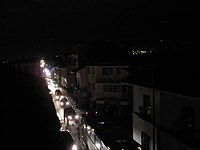
Photo from wikipedia
Abstract This paper considers two commercial and residential buildings for building energy resilience against natural disasters that cause a power outage. The buildings are modeled with a shared parking station… Click to show full abstract
Abstract This paper considers two commercial and residential buildings for building energy resilience against natural disasters that cause a power outage. The buildings are modeled with a shared parking station for their electric vehicles. The peer-to-peer operation is modeled for the buildings. The electric vehicles inside the parking station have dissimilar patterns of availability and such dissimilarity helps the buildings to be benefited from the vehicles for extra hours. The power outage is modeled at different day hours and with various durations. The building is supported by energy management options to handle such disruptions. The options are a peer-to-peer operation of the building, electrical vehicle charging-discharging, partial charge ability, load curtailment, and load adjustment. The proposed model only utilizes available components of the buildings and it does not need to install further components. The purpose is to minimize energy cost and maximize energy resilience under natural disasters. The resilience is defined as critical load restoration and minimum energy loss under various power outages. The results demonstrate that the designated energy management options can practically minimize energy cost and improve energy resilience following blackouts. The electric vehicles can reduce energy cost by about 25% and supply the loads under 7-hour power outage.
Journal Title: Energy
Year Published: 2021
Link to full text (if available)
Share on Social Media: Sign Up to like & get
recommendations!